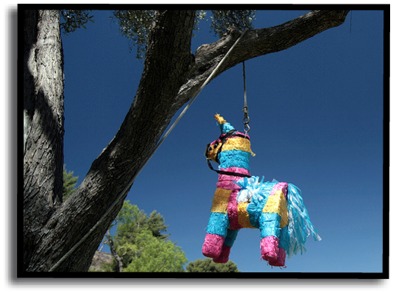Posted by Nicky Drayden on Apr 3, 2010 in
Reviews Phew! Well, I made it through March, barely. Turns out there are lots of good stories out there without any sort of character arc whatsoever, which made finding those with them a little tricky.
We’ve got four stories to look at this month:
Review #14: Bearing Fruit by Nikki Alfar A young woman bathing in a creek gets knocked up by an errant mango, then sets off to find the father of her child.
Review #15: The Kiss by Lauren LeBano A little girl has a goblin for a playmate, but as she matures, she learns he’s after more than just her friendship.
Review #16: Saving the Gleeful Horse by K.J. Bishop A giant living under a bridge makes a questionable bargain to save a special little horse from a cruel fate.
Review #17: Bridesicle by Will McIntosh A half-frozen mail order bride’s life depends on the delicate lies and sweet nothings she whispers into the ears of strangers.
So out of the dozen or so short stories I read this month, these four were the only ones where a character arc stood out to me. It’s not a huge sample, but I feel comfortable enough to say that short stories have character arcs at least as often as they don’t. Maybe it’s too much to expect characters to grow in 5000, 3000, 1000 words. Certainly, if the change comes across too abruptly, then the arc will feel artificial or corny. It’s also possible that my tastes for science fiction and fantasy have more of a literary slant, and maybe if I’d read more pulp or action/adventure styles, I’d come to a different conclusion.
Nevertheless, the four stories for this month’s craft focus did character arcs well, and good ones do give me the warm and fuzzies inside. So what made them work? In Bearing Fruit, the character goes through physical changes as well as emotional ones. She’s mysteriously pregnant and being ostracized by her family and friends, and yet decides to take control of the situation and seek out the unknown father of her child. She goes from innocent and carefree to vengeful to calculating along her journey, and tries to claim her happily-ever-after back however she can get it. She makes the hard choices, and as a result, grows as a person.
Annie also makes some tough decisions in The Kiss. She decides not to banish the goblin out of her life completely despite her mother’s worries. She kisses the goblin when she’s feeling vulnerable, and offers up her own child to him when her life as a single parent becomes more than she can bear. Annie appears to be going through changes on the outside — dealing with the complexities of life as she goes from childhood to adulthood, but something at her core remains the same: the way she uses the goblin and is never really a true friend to him. Annie’s arc leads her right back to where she started, a bratty little girl who barely cares about the feelings of others.
The characters in Saving the Gleeful Horse and Bridesicle also make tough decisions, which makes me wish I would have gone back and studied more stories that didn’t have character arcs to see what types of decisions those characters had to make. Maybe forcing characters into these lose-lose situations is an effective tool for revealing character. I’m not going to lie, this craft focus was a tough one for me. I didn’t know what to expect or really what I was looking for, but this definitely makes me want to look more closely at this topic in the future. But at least I got to read some amazing stories, which is never a bad thing.
March’s Must Read goes to the story with the character arc that rang the truest to my ear, a happily-enough-ever-after tale where when life hands you mangos, you make mango-ade: Bearing Fruit by Nikki Alfar!
Posted by Nicky Drayden on Apr 2, 2010 in
Reviews Published by: Asimov’s Science Fiction, 2009
 Photo by Kodismom Creative Commons
Photo by Kodismom Creative Commons
The Story:
Mira died in a car accident, but that’s not the worst of her problems. She’s now a bridesicle — half icicle, half mail order bride — waiting for her prince charming to revive her cryogenically frozen body. Only it’s not exactly the princes that go to the dating centers of the dead. It’s the weirdos, the perverts, and the old men looking for the affection of pretty young things. And apparently not even those types are interested in Mira. She slips in and out of death, for decades on end, trying to convince her would be suitors to give her a second chance at life in exchange for her hand in marriage. Her future depends on the sweet nothings she can mutter form her cold, blue lips, wooing men with her flaccid face and dead eyes…
The Craft: Character Arcs
SPOILERS
Mira wakes up eighty years after her death, unable to move anything thing besides her face. She quickly learns that she’d been frozen after her accident, and is now at the mercy of the men visiting her icy crypt to pay for her revival. The world Mira had known is gone, including her mother, whose consciousness had been implanted in Mira’s brain. Mira has considerable guilt about losing her mother, despite that her mother hadn’t done much to deserve such sentiment. Having her mother constantly in hitching along on her thoughts, judging her every move, and second guessing her decisions had made Mira’s life a living hell, and she’s relieved to finally be rid of her.
But trapped in a half-death, Mira now has bigger problems, namely getting the nerve to convince some desperate schmuck that she’ll love him only if he’ll free her. She’s got guilt about this too. She’s never had to deceive, and she lies to Lycan, a shy, overweight man who visits her on occasion. It pains her not be herself, to bend to fit his fantasy of a woman and to tell him the sweet things he so desperately wants to hear. Mira finds the strength within her to pretend she’s interested in him, even though in life, she hadn’t been interested in men at all. As it turns out though, Lycan had secrets of his own. He doesn’t have the money to revive Mira.
The good news is that Mira learns that her girlfriend Jeanette had been frozen, too, and Lycan passes a message to her, just a few crypts away. Mira’s outlook changes instantly, and now she truly has something to live for. Another century or so passes before she gets her next chance at freedom, from an orange-tinted attorney looking for a surrogate to birth a child for him and his late wife, who’s hitching in his head. And apparently it’s pretty crowded in the orange man’s brain, who’s Lycan’s grandson as it turns out. Lycan’s hitching too, trying to convince the orange man and his wife to choose Mira as the surrogate. Mira makes a case for herself, tries to say all the right things, but it’s just not enough. Finally, she tells the truth, that she’s gay, hoping it’ll ease the wife’s jealousy.
Mira never liked having her mother as a hitcher, but she admires how the orange man and his family coexist in a sort of marital bliss. After she’s free and raising her child, she decides she wants to experience a that bliss for herself. She doesn’t have the money to revive Jeannette, but she’s got enough to get her consciousness implanted. They’ll be together through this life at least, and maybe more. In this delightfully odd Nebula Award contender, Mira is stuck in a state where she must constantly reevaluate her morals and motives in her search for freedom. She betrays herself, but at the same time, grows into a stronger woman, realizing that she doesn’t need to be anchored down by the guilt and hurt from past lives. She also realizes that she’d given up too soon on love, the one thing that’s able to transcend death, even without fancy technology.
Tags: Asimov's, brides, character arcs, Nebula, queer fiction, science fiction
Posted by Nicky Drayden on Mar 27, 2010 in
Reviews Published by: Fantasy Magazine, March 22, 2010
 Photo by Peasap Creative Commons
Photo by Peasap Creative Commons
The Story:
Molimus, a great giant so broad it takes four men’s shirts stitched together to clothe him, lives under a bridge collecting flotsam for trade. From his vantage, he witnesses the assassinations of marvelous, colorful animals, beaten to death by the sticks and swords of children. Molimus can’t believe how cruel these children are, taking pleasure in the kill, then plundering the prizes that tumble out of the animals’ carcasses — prizes like caramels and toy rings.
When Molimus finds a vibrant little horse that had somehow lived through a savage beating, he decides to nurture it back to health. Though it’s full of holes, the horse remains in good cheer, but beyond bandaging up the wounds, Molimus knows nothing of how to give life back to the horse. So he sets out to see the White Ma’at, an old, old woman who knows all and sees most.
The Craft: Character Arcs
SPOILERS
In the first part of the story, Molimus’s character comes off as gentle and compassionate, yet spiteful. Despite his size and strength, his occupation is one of quiet and patience, sifting through the flotsam passing under his bridge for objects of value to barter. Molimus has a strong sense of morality, and feels strongly about the atrocities the children bring upon such magnificent creatures. He opens his heart up to one such creature, a horse struggling for survival, and takes it upon himself to nurse his Gleeful Horse back to health.
Molimus’s compassion and spite are shown again later in the story when he visits the White Ma’at. Even though she tells Molimus that the children are not to blame, for they do not see the animals as living as they do, Molimus hangs on to his hatred of the children for their vile acts. However, he’s sensitive enough to realize that something is troubling the White Ma’at, and he knows that she must be tired of the prison she finds herself in, trapped in her home by Prince November. Molimus feels for her, and he wants to save the Gleeful Horse, so he makes a deal with the White Ma’at that will help them both.
Molimus is tasked with filling the Gleeful Horse with treasure to restore its life, but the White Ma’at tells him that it’s not the trinkets that spill from the treasure animals’ wounds that he must find. He needs to collect starlike pieces, which are only found in living things, most abundantly in children. Molimus, who’s been full of compassion and virtue up until now, starts to feel something else — shame. The shame, now tangible in Molimus’s throat, gets coughed up, and once he’s rid of it, he’s able to go on his journey. He steals life from children and splits it between the White Ma’at so she can build power to escape Prince November, and his Gleeful Horse which devours the life quickly, requiring Molimus to harvest more and more.
While Molimus’s intentions are good, he goes from a gentle giant to a monster, and in the grand pursuit of saving one life, he’s forced to take the lives of countless others. Maybe Molimus beleived deep down that the children were innocent of their cruelty. Maybe that’s why he had felt qualms about the deal he made with the White Ma’at. The possiblities are fun to think about, and I like that the truth is not explicity spelled out. I enjoyed sharing Molimus’s journey with him, though I’m grateful I could do so without sharing his fate.
Tags: character arcs, fantasy, Fantasy Mag, horses, piñata


